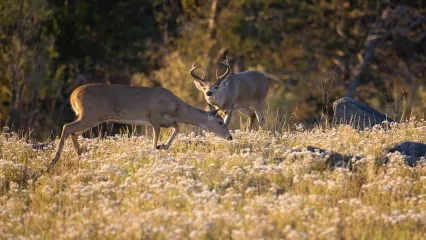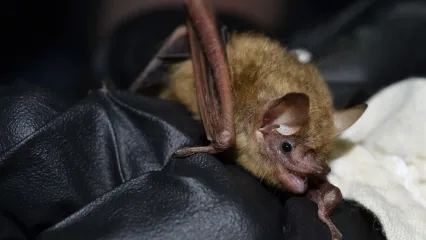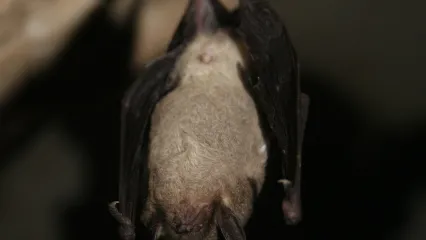
Description
A quick flash of white, a burst of speed, and a white-railed deer bounds away on impossibly slender legs, almost gliding over the ground toward a curtain of concealing brush. This popular species (Odocoileus virginianus) exists in all 77 Oklahoma counties, and many Oklahomans are discovering what hunters already know-watching the white-tailed deer can be fascinating ... and addictive.
A member of the Cervidae family, which also includes moose, elk, and caribou, the white-tailed deer has a thick can or brown coat in the summer that fades to grayish brown in the winter. The name "white-tailed deer" refers to the white underside of the rail. When the deer is alarmed or running, the tail is held conspicuously erect like a flag. It has white markings around its eyes and nose, as well as on its throat and stomach. Its oversized ears aid the skittish creature in picking up the sounds of predators, and its small black nose detects even the faintest of scents. While some other hoofed mammals have permanent, hollow horns, male white-tailed deer grow and shed antlers every year once they reach the age of two.
White-tailed deer are herbivores or plant-eaters. The deer's diet changes with the seasons, from green plants in the spring and summer to acorns, corn, and other nuts in the fall. In winter when food is scarce, it will consume bark, buds, and the twigs of woody plants. Not one to pass up a tasty treat, the white-tailed deer will also feast on flower and vegetable gardens if given the chance.
Besides their senses of smell and hearing, whitetails' natural defense is their breathtaking speed. Even in dense forest, the deer can reach the speed of 40 miles per hour as they bound over obstacles. They are also good swimmers and can retreat to streams and lakes to avoid predators.
The white-tailed deer is the most popular big game animal in Oklahoma, which is remarkable considering its near extinction at the turn of the century. A brief history of the white-tailed deer in Oklahoma reads as follows: 1870s-deer abundant; 1890s-reckless over-harvest by settlers; 1910s-barely 500 remain and deer seasons close; 1930s-restoration begins; 1980s-stable and abundant statewide herd restored. Thanks to the hard work of generations of conservationists, the deer population has been restored to its former glory.
Habitat
Deer inhabit all types of Oklahoma terrain but prefer open woodland. They follow established paths to and from their food sources, and feed in the early morning and late afternoon.
Life Cycle
One to three fawns are born six months after mating, and arc reddish-brown with white spots. Fawns can walk at birth, and can even forage for food a few days later. While the doe looks for food, she hides the fawns in heavy cover where they lie well-camouflaged against the ground. Fawns may lie quietly for up to four hours until the mother returns.
Fawns stay with the mother for the first year, after which, the male yearlings venture out on their own. Female offspring leave after two years. Deer live in family groups of a doe and her fawns. Bucks live either alone or in small groups of three to four.
Male deer are known as bucks, and females are does.
How To Observe
Though hunters go afield with the goal of harvesting a whitetail, many spend the day simply watching this magnificent creature. More and more non-hunters are joining them. If you want to catch sight of the majestic and graceful whitetail, early morning and late afternoon, when the deer are feeding, is the best time to spot one. Just be careful not to startle one, or else all you'll see is the "white tail" waving good-bye.
One of the most interesting times to observe "whitetails" is during the mating, or rutting season. Mating occurs in the fall when males will fight by butting and dashing antlers to win access to a doe. Antler size is part of what determines social status in the herd, and a larger rack can increase mating chances. Males will also use their antlers to strip the bark off of saplings or lowhanging branches and paw at the ground to create a "scrape," an area of exposed earth that they mark with scent. Numerous scent glands cover the legs of the deer, and the secretions mark their territory during the rutting season.

